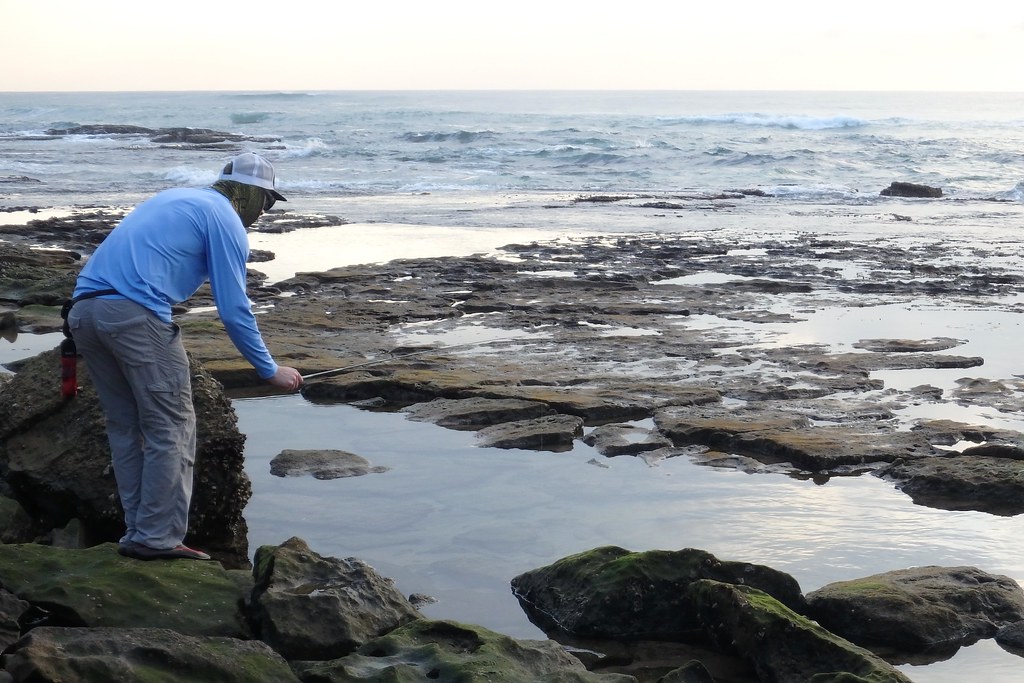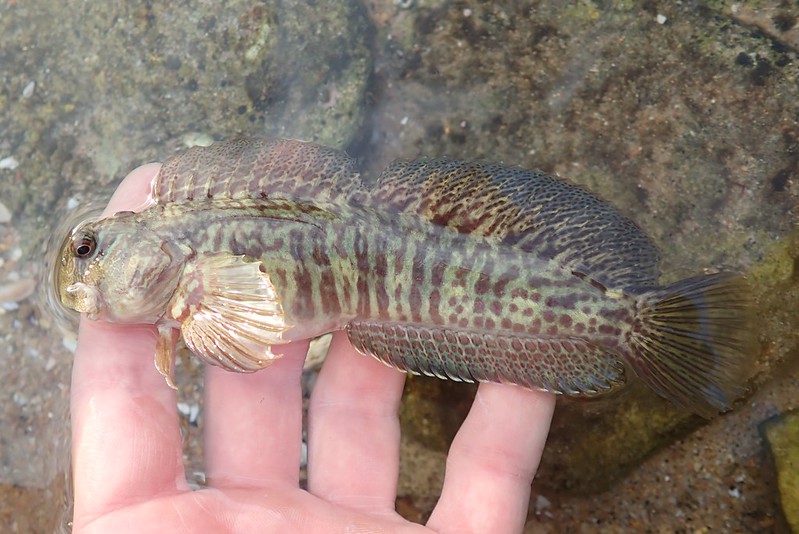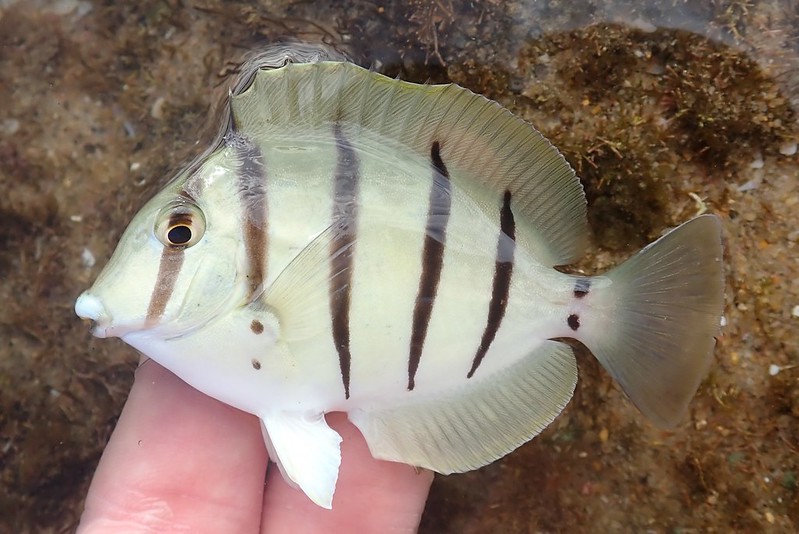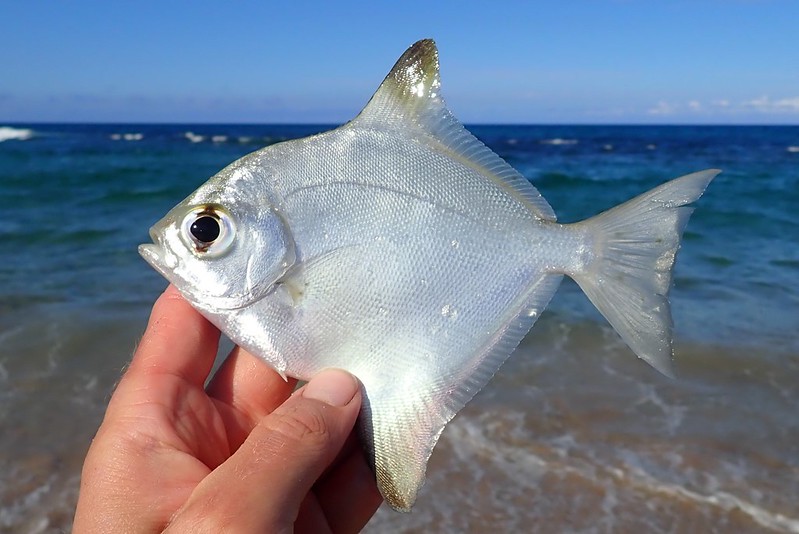
The next morning we got up early and drove to Mission Rocks, which was about 30 minutes to the north in the iSimangaliso Wetland Park. The tidepools looked great on Google Maps, and we timed our visit during a really good low tide. I don't know about the other guys, but I've never been so excited to go tidepool fishing. We expected a good mix of tropical species with how far north of Durban we were.

Photo courtesy of Josh Leisen.
I started off fishing a big shallow pool far from the surf. The first fish I caught was the damselfish that I had dropped without a photo at Tinley Manor, so it was nice to officially add it to the list. After that I spent quite a while convincing one of rockskippers that my bait was ok to eat, and I caught another frill-goby in case it was a new species.
Blackspot Sergeant (Abudefduf sordidus) - new hook & line species #613
Rippled Rockskipper (Istiblennius edentulus) - new hook & line species #614
Cocos Frill-Goby (Bathygobius cocosensis)
Josh and Eli had been fishing off the rock ledge into open water, so I gave that a try next. I didn't catch any new species, but I got nice photo upgrades for Cape white seabream and the blackspot sergeant that I had just caught.
Cape White Seabream (Diplodus capensis)
Blackspot Sergeant (Abudefduf sordidus)
After that I found a tidepool that had the occasional wave washing into it. Back in San Diego I've found tidepools like that to be especially productive because the fish are expect food to wash in with the waves. That was the case here as well, and once I got the timing down (drop your bait in right towards the tail end of the wave washing in), I was able to catch three more small species. The convict surgeonfish is one I'm particularly proud of.
Convict Surgeonfish (Acanthurus triostegus) - new hook & line species #615
Singlebar Devil (Plectroglyphidodon leucozonus) - new hook & line species #616
Barred Flagtail (Kuhlia mugil) - new hook & line species #617
I tried blind fishing in deeper pools with a lot of cover, and in one of them a klipfish dashed out and grabbed my bait. Klipfish are the local name for kelpfish, and they behave pretty much the same as the ones in California. They really don't like lying flat for a photo.
Grass Klipfish (Pavoclinus graminis) - new hook & line species #618
In the afternoon the tide was coming in, and pretty soon the waves were washing over the big rock slab with all the tidepools. It was last call for catching new species out of the pools, so I walked around looking for something different to catch my eye. What caught my eye was a small moray! The first one I hooked broke my line, but I retied and quickly found another. Catching it was easy, now how on earth would I get a decent photo?
The solution I came up with was to clamp his lip with my forcep pliers. I don't think it did any damage to him, and it allowed me to straighten him out for a quick photo before I released him. He definitely didn't enjoy the ordeal, swimming away in a hurry when I put him back in the water. Before we retreated from the rocks I found one more new damselfish species.
Snowflake Moray (Echidna nebulosa) - new hook & line species #619
Yellowtail Sergeant (Abudefduf notatus) - new hook & line species #620
Eli was fishing to the south, but Josh and I had our eyes on the beach to the north. We had an agreed upon time to meet back at the car, so we worked our way over the rocks to the beach to try surf fishing for different species than we found in the tidepools.
When I flipped my bait out into the water I felt little bites, which was a good sign. When I felt bites and pulled in my line with the hook bit off, I knew we had a puffer to catch. After retying twice I had the little culprit in my hand. His eyes were filled with pure evil.
Evil-Eye Puffer (Amblyrhynchotes honckenii) - new hook & line species #621
We spent the rest of the afternoon further to the north at Cape Vidal, which is a world famous fishing spot. There's a nice rock jetty there that's exposed at low tide, but unfortunately it was submerged by the time we got there. We fished for a while, but there wasn't much action close to shore. We caught a few small fish though, and I was happy to finally pick up the pompano that Eli had caught the day before.
Largespotted Dart (Trachinotus botla) - new hook & line species #622
Silver Moony (Monodactylus argenteus)
It was a long and productive day, and we ended it by lying out on the beach and enjoying the breeze and the sounds of the ocean. It felt good to lie flat on our backs instead of hunched over tidepools trying to catch tiny fish.
















No comments:
Post a Comment
Note: Only a member of this blog may post a comment.